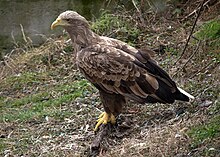White tailed eagle
| White-tailed eagle | |
|---|---|
 |
|
| In captivity | |
| Scientific classification | |
| Kingdom: | Animalia |
| Phylum: | Chordata |
| Class: | Aves |
| Order: | Accipitriformes |
| Family: | Accipitridae |
| Genus: | Haliaeetus |
| Species: | H. albicilla |
| Binomial name | |
|
Haliaeetus albicilla (Linnaeus, 1758) |
|
 |
|
| Range of H. albicilla Nesting range Wintering range Year-round range | |
| Synonyms | |
|
Falco albicilla Linnaeus, 1758 |
|
Falco albicilla Linnaeus, 1758
Haliaeetus albicilla albicilla
Haliaeetus albicilla groenlandicus
White-tailed eagle (Haliaeetus albicilla) are also known as eagle of the rain, sea grey eagle, erne, gray eagle, and white-tailed sea-eagle — is a large bird of prey in the family Accipitridae which includes other raptors such as hawks, kites, and harriers. It is considered a close cousin of the bald eagle and occupies the same ecological niche, but in Eurasia.
The first formal description of the white-tailed eagle was by the Swedish naturalist Carl Linnaeus in 1758 in the tenth edition of his Systema Naturae under the binomial name Falco albicilla. The genus Haliaeetus was introduced in 1809 by the French naturalist Marie Jules César Savigny in the Description de l'Égypte. The name Haliaeetus is New Latin for "sea-eagle", from Ancient Greek hali-, "sea-" and aetos, "eagle". The specific albicilla, "white-tailed", is from New Latin albi-, "white" and cilla, "tail".
The white-tailed eagle is a very large bird. It measures 66–94 cm (26–37 in) in length with a 1.78–2.45 m (5.8–8.0 ft) wingspan. The wingspan, with a midpoint of 2.18 m (7.2 ft), is on average the largest of any eagle. The Steller's sea eagle, larger in both weight and total length, is the closest rival for median wingspan amongst living eagles. The bald eagle is roughly the same size as the white-tailed eagle, although has a shorter average wingspan and usually longer total length, due to a longer tail. Females, typically weighing 4–6.9 kg (8.8–15.2 lb), are slightly larger than males, which weigh 3.1–5.4 kg (6.8–11.9 lb). The record weight for the species was 7.5 kg (17 lb) for a specimen from Scotland, while a more recent huge female from Greenland reportedly spanned 2.53 m (8.3 ft) across the wings. Among standard measurements, the wing chord is 55.2–71.7 cm (21.7–28.2 in), the tail is 25–33 cm (9.8–13.0 in), the tarsus is 9.2–10.1 cm (3.6–4.0 in) and the exposed culmen is 6–6.5 cm (2.4–2.6 in). Size variation is generally a clinal trend: measurements of eagles from Greenland are in general larger than in other populations of the species, while those from the (now discontinuous) population in the Middle East, at the southern extreme of this species distribution, are the smallest in the species. The white-tailed eagle is sometimes considered the fourth largest eagle in the world and is on average the fourth heaviest eagle in the world.
...
Wikipedia

